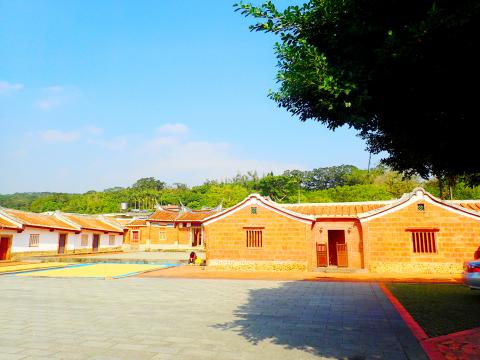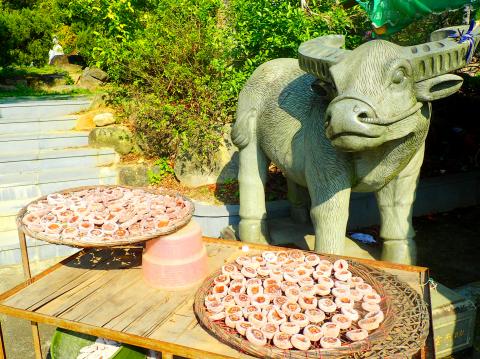Arriving back in Taipei after spending Christmas at home in England, I was immediately struck by how much less cosmopolitan the city streets of Taipei are than those of London. Despite its small but vibrant expat community, modern, clean transport infrastructure and the mushrooming growth of impressive, Western-style tower blocks, Taiwan still feels very “Taiwanese.”
On a deeper level, though, the nation’s population really is quite a cosmopolitan one after all, from the original Aboriginal inhabitants to more recent settlers such as the soldiers who arrived with Chiang Kai-shek (蔣介石), making it their home after the Chinese Nationalist Party (KMT) retreat from China in 1949. Taiwan’s citizens really are an interesting mosaic of different traditions, cultures and even languages.
HAKKA TRADITIONS

Photo: Richard Saunders
The Hakka (客家), for instance, have their own language and cultural traditions, a distinct (and delicious) cuisine and their own TV channel. Explore the towns and villages of the northwest from Taoyuan to Miaoli counties, and you’ll soon find Hakka communities, traditional Hakka sanheyuan (三合院, traditional three-section compound) houses and, of course Hakka restaurants, selling bantiao noodles (粄條), meigan kourou (梅干扣肉, braised pork belly with pickled vegetables), Hakka stirfry and other classic Hakka dishes. You’ll also hear the distinctive tones of the Hakka language, which villagers generally prefer to use when talking to each other.
A couple of Hakka villages have become popular. The best-known is probably Beipu Township (北埔), which attracts crowds on sunny weekends, while more recently the picturesque Nanjhuang Township (南庄) has become a popular destination too. A notch or two below those in the popularity stakes, but if anything even more interesting, is the town of Sinpu Township (新埔).
Despite its name (which means “new village”), Sinpu has a relatively long history, and was already a commercial center during the early nineteenth century. Today it has a low-key atmosphere that’s very pleasant, and there’s plenty of historic and cultural interest to merit a visit.

Photo: Richard Saunders
The town is especially famous for its delicious dried persimmons, which are a Hakka specialty, and in season from about September to December, so at that time keep your eyes out for them drying in the sun in yards and open areas along the town’s back streets. Sinpu’s other famous edible delight is Hakka bantiao noodles; aim to have lunch at the famous Risheng Bantiao (日勝粄條), which serves various cheap but delicious dishes.
OLD STREET
The town’s main old street, Jhongjheng Road (中正路), the main road through town, has a couple of interesting buildings, especially the Japanese-era Guihuayuan (桂花園) and the Catholic church, built in a Western colonial style in 1955.

Photo: Richard Saunders
For the town’s older historical relics, try side roads such as Heping Street (和平街), which forks off Jhongjheng Road beside the town’s tiny bus station. Follow Heping Street on the right for a few minutes west past the morning market is Risheng Bantiao. It’s been popular for decades — photos on the wall proclaim it was a favorite of former president Chiang Ching-kuo (蔣經國), and it’s packed at lunchtimes, even during the week, so arrive before noon to avoid a wait.
A few hundred meters west is the small Zhu Family Shrine (朱氏家廟), dating from 1846 and beautifully restored, while nearby is the fine Pan Mansion (潘宅), built in 1861. Across the road from the mansion steps lead down to a stone trough where, as at the more famous example in Nanjhuang, the town’s women once washed their clothes in the natural spring water. Recent development of this side of the street has put in new walkways and destroyed some of its former character, although the paths make it easier to get off the road and down to the stream.
A few doors further west along Heping Street, the Liu Family Shrine (劉氏家廟) is perhaps the most beautiful of the three old buildings along this street.

Photo: Richard Saunders
Several other fine old buildings are dotted around town, a couple of which are still being repaired, and have disappeared under a sea of scaffolding and corrugated iron rain roofing, but Sinpu’s finest example of traditional architecture lies splendidly restored four kilometers west, on Route 14. Just after passing under the raised tracks of the high-speed railway, the Liu House (劉厝) is easily missed, set-back from the road down a short drive. It’s a very fine Minnan-style sanheyuan and, unusually, it’s open to the public.
YIMIN TEMPLE
A further two kilometers west, the area’s most famous attraction, Sinpu-Fangliao Yimin Temple (新竹縣新埔枋寮義民廟) stands set back from Route 14 behind an imposing temple gate. The current temple is neither especially large nor old, but it’s the site, each year, of one of Taiwan’s more imposing traditional ceremonies, and the biggest Hakka celebration of the year, in honor of the “righteous citizens” for whom the temple was built.
Held on the 20th day of the seventh lunar month (alongside Ghost Festival rituals) the ceremony commemorates a Hakka uprising in 1721 against oppressive Han Chinese authorities. The dead from the uprising were buried on the site where the temple now stands, and the collective tomb can be seen behind the main building.
IF YOU GO
Sinpu is served by bus 5621 from Hsinchu, which passes both Yimin Temple and the Liu House on the way.
Richard Saunders is a classical pianist and writer who has lived in Taiwan since 1993. He’s the founder of a local hiking group, Taipei Hikers, and is the author of six books about Taiwan, including Taiwan 101 and Taipei Escapes. Visit his Web site at www.taiwanoffthebeatentrack.com.

When Taiwan was battered by storms this summer, the only crumb of comfort I could take was knowing that some advice I’d drafted several weeks earlier had been correct. Regarding the Southern Cross-Island Highway (南橫公路), a spectacular high-elevation route connecting Taiwan’s southwest with the country’s southeast, I’d written: “The precarious existence of this road cannot be overstated; those hoping to drive or ride all the way across should have a backup plan.” As this article was going to press, the middle section of the highway, between Meishankou (梅山口) in Kaohsiung and Siangyang (向陽) in Taitung County, was still closed to outsiders

President William Lai (賴清德) has championed Taiwan as an “AI Island” — an artificial intelligence (AI) hub powering the global tech economy. But without major shifts in talent, funding and strategic direction, this vision risks becoming a static fortress: indispensable, yet immobile and vulnerable. It’s time to reframe Taiwan’s ambition. Time to move from a resource-rich AI island to an AI Armada. Why change metaphors? Because choosing the right metaphor shapes both understanding and strategy. The “AI Island” frames our national ambition as a static fortress that, while valuable, is still vulnerable and reactive. Shifting our metaphor to an “AI Armada”

US President Donald Trump may have hoped for an impromptu talk with his old friend Kim Jong-un during a recent trip to Asia, but analysts say the increasingly emboldened North Korean despot had few good reasons to join the photo-op. Trump sent repeated overtures to Kim during his barnstorming tour of Asia, saying he was “100 percent” open to a meeting and even bucking decades of US policy by conceding that North Korea was “sort of a nuclear power.” But Pyongyang kept mum on the invitation, instead firing off missiles and sending its foreign minister to Russia and Belarus, with whom it

The Chinese Communist Party (CCP) has a dystopian, radical and dangerous conception of itself. Few are aware of this very fundamental difference between how they view power and how the rest of the world does. Even those of us who have lived in China sometimes fall back into the trap of viewing it through the lens of the power relationships common throughout the rest of the world, instead of understanding the CCP as it conceives of itself. Broadly speaking, the concepts of the people, race, culture, civilization, nation, government and religion are separate, though often overlapping and intertwined. A government